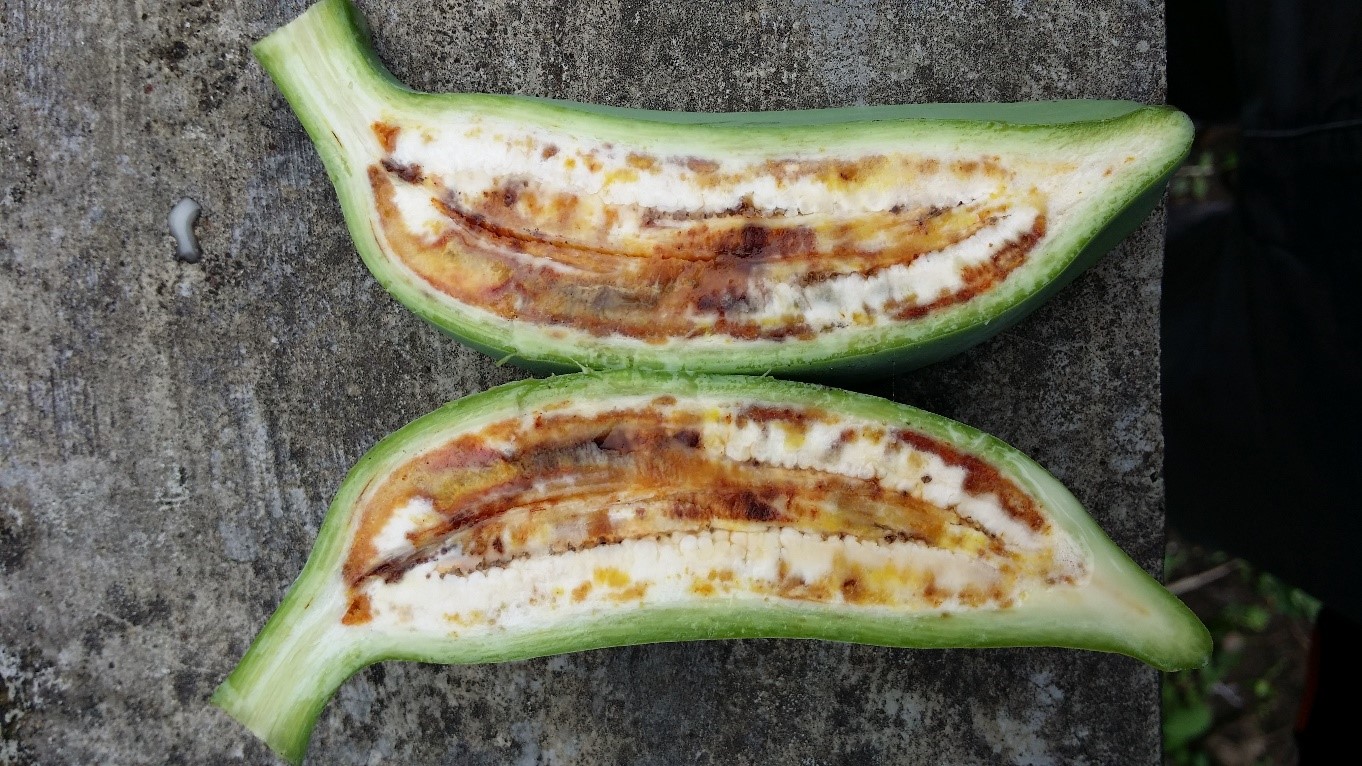Collaboration
The Queensland Alliance for Agriculture and Food Innovation (QAAFI) encourages the development of strong connections and links with relevant and leading research organisations in the world in our quest to improve agricultural productivity and profitability for the benefit of all.

A deadly banana disease that first caused problems in South Sulawesi over a century ago has now spread across the Indonesian Archipelago and to peninsular Malaysia – posing a threat to Australia’s $600 million banana growing industry in northern Australia.
Banana blood disease was named after the red-brown discoloration when visibly healthy looking green banana fruit are cut.
The pathogen that causes banana blood disease impacts on most banana varieties and no effective resistance has been identified so far. For infected territories, banana blood disease is now be considered one of the most important banana diseases.
QAAFI at the University of Queensland plays a key role in helping protect the banana industry through a project funded by Hort Innovation and the Queensland Department of Agriculture and Fisheries, led by Professor André Drenth
The objective of this project is to improve the detection, identification and incursion management of exotic banana diseases.
Bananas originated in Southeast Asia with Indonesia and Papua New Guinea playing a key role in the evolution of the world’s most popular fruit. However, many micro-organisms that cause disease in bananas have co-evolved with the fruit in these countries that neighbour Australia to the North.
One disease of particular concern is banana blood disease caused by the bacterium Ralstonia syzygii subsp. celebesenis which belongs to a group of pathogens that cause bacterial wilts in banana, and is related to Moko disease.
This pathogen first caused problems in South Sulawesi in the early start of the 20st century. The Dutch colonial administration quarantined this area and for over 60 years the pathogen remained contained to Sulawesi. However, in 1987 it turned up in Java and since that time it has spread rapidly over the Indonesian Archipelago and also invaded peninsular Malaysia.
Blood disease symptoms
Symptoms of banana blood disease include characteristic red brown vascular staining toward the centre of the pseudostem, wilted and necrotic leaves, with fruit bunches that appear outwardly healthy but are internally stained red/brown, rotten and inedible. Blood disease results in reduced numbers of marketable bunches and causes significant wilting, generally reducing the vigour of the tree and killing whole plants in severe cases.
Banana blood disease is one of the key target pathogens in Professor Drenth’s Hort Innovation project. His research is focused on the occurrence, spread, vectors, mode of infection, and improvements in management of such diseases which will help both countries.


Surveys
The banana blood disease research got a boost from a Bilateral Plant Biosecurity Initiative between Australia and Indonesia led by the Cooperative Research Centre for Plant Biosecurity that sought to fund small projects with potentially a large impact.
Working with Dr Wayan Mudita from Nusa Cendana University in West Timor, Professor Drenth undertook a small project to conduct several surveys to determine the extent and impact of banana blood disease in Indonesia. From a series of surveys undertaken on several of the large islands of Indonesia, it became clear that the banana blood disease problem was more widespread than initially thought.
During the term of this grant, the Ministry of Research, Technology and Higher Education of the Republic of Indonesia awarded Professor Drenth a World Class Professorship at the University Gadjah Mada in Yogyakarta in 2017. This initiative provided funding for further surveys and training, as well as infrastructure support for the Indonesian researchers. This support enabled Professor Drenth to spend some time at Gadjah Mada University, working with Professor Siti Subandiyah, the Head of Research Center for Biotechnology, in 2017.
Collaboration
Strong collaboration between the Australian and Indonesian researchers has resulted in Australian and Indonesian students being co-supervised by members of both teams.

Significant gaps were identified in the understanding of banana blood disease and a series of field trials are undertaken in Indonesia to gain an understanding of the infection and spread of this pathogen. This experimental work, undertaken by Professor Drenth and Professor Subandiyah, is funded by a grant from the Australian Plant Biosecurity Science Foundation.
Ms Jane Ray, working as a PhD student on this project, was awarded a 2019 Endeavour Cheung Kong Research Leadership Award, enabling her to spend up to six months in Indonesia working on the infection biology and epidemiology of the banana blood disease.
In March 2019 the Crawford Fund awarded Professor Drenth an International Engagement Award which will further strengthen the established links with Gadjah Mada University and Nusa Cendana University through funding Professor Drenth to conduct training and mentoring to young Indonesian scientists in the area of plant pathology.
Win-win
The banana blood disease research demonstrates QAAFI’s capability to initiate and develop successful national and international research programs which attract funding from a range of different sources.
A better understanding of the disease will aid Indonesia’s banana growers to reduce the impact of the disease. This will in turn reduce the risk to Australia and will allow for testing and validation of identification techniques developed in Australia – a win-win situations for all parties involved in the collaborations.
 Sustainable cultivation of bananas
Sustainable cultivation of bananas
In addition to collaborating with developing countries, Professor Drenth his team also have strong collaboration with Professor Gert Kema from Wageningen University, in the Netherlands.
Professor Drenth and Professor Kema are co-editors of a series of books on the sustainable cultivation of bananas, with Volume 1 published in 2018.
Contact: Professor Andre Drenth, Professorial Research Fellow, QAAFI Centre for Horticultural Science, University of Queensland, T. +61 7 3443 2460 or E. a.drenth@uq.edu.au



